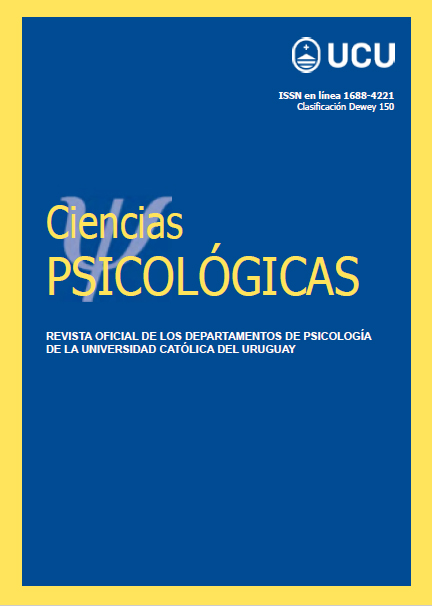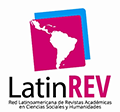Gaslighting en las relaciones íntimas: una revisión de alcance
DOI:
https://doi.org/10.22235/cp.v19i2.4477Palabras clave:
gaslighting, relaciones íntimas, violencia psicológica, revisión del alcanceResumen
Este estudio realizó una revisión de alcance sobre el gaslighting en las relaciones íntimas, con el objetivo de analizar cómo la literatura científica ha estudiado el fenómeno en adultos, sin restringir los estudios en función del sexo, la identidad de género o el tipo de relación afectiva de los miembros de la pareja implicados. La búsqueda se realizó en las bases de datos Scopus, CINAHL, MEDLINE, PsycNet, PubMed, PsycInfo y Sage Journals, y una búsqueda complementaria en Google Scholar con el objetivo de localizar estudios nacionales no indexados en revistas de alto impacto. Los resultados dieron lugar a 14 estudios considerados aptos para su inclusión en el análisis principal. Los resultados mostraron que el gaslighting en las relaciones íntimas ha sido investigado desde siete perspectivas principales: factores de riesgo y predictores, tácticas o mecanismos, motivaciones, herramientas de evaluación, daño causado a las víctimas, estrategias de afrontamiento y variables correlacionadas con el gaslighting. Es importante señalar que los artículos seleccionados adoptaron un diseño muestral de conveniencia, compuesto predominantemente por muestras femeninas, lo que puede influir en la comprensión de este fenómeno. En resumen, se espera que los resultados de este estudio puedan contribuir al desarrollo de nuevas investigaciones sobre el fenómeno, especialmente en el contexto brasileño, y posibilitar la discusión de estrategias de intervención que busquen identificar, prevenir y lidiar con esa forma de violencia en las relaciones amorosas, a fin de promover relaciones más saludables.
Descargas
Citas
Abramson, K. (2014). Turning up the Lights on Gaslighting. Philosophical Perspectives, 28(1), 1-30. https://doi.org/10.1111/phpe.12046
Akdeniz, B., & Cihan, H. (2023). Gaslighting and interpersonal relationships: Systematic review. Psikivatride Güncel Yaklaslmlar-Current Approaches in Psychiatry, 16(1), 146-158. https://doi.org/10.18863/pgy.1281632
Aromataris, E., Lockwood, C., Porritt, K., Pilla, B., & Jordan, Z. (Eds.) (2020). JBI manual for evidence synthesis. JBI. https://doi.org/10.46658/JBIMES-24-01
Asen, E., & Fonagy, P. (2017). Mentalizing family violence Part 2: Techniques and interventions. Family Process, 56(1), 22-44. https://doi.org/10.1111/famp.12276
Augustin, L. W., & Bandeira, C. C. de A. (2020). Postura e intervenções do gestalt-terapeuta frente à violência psicológica contra a mulher por parceiro íntimo. Revista da Abordagem Gestáltica, 26(SPE), 449-459. https://doi.org/10.18065/2020v26ne.9
Barton, R., & Whitehead, J. A. (1969). The Gas-light phenomenon. The Lancet, 293(7608), 1258-1260. https://doi.org/10.1016/S0140-6736(69)92133-3
Bashford, J., & Leschziner, G. (2015). Bed partner “Gas-Lighting” as a cause of fictitious sleep-talking. Journal of Clinical Sleep Medicine: JCSM: Official Publication of the American Academy of Sleep Medicine, 11(10), 1237-1238. https://doi.org/10.5664/jcsm.5102
Bellomare, M., Genova, V. G., & Miano, P. (2024). Gaslighting exposure during emerging adulthood: Personality traits and vulnerability paths. International Journal of Psychological Research, 17(1), 29-39. https://doi.org/10.21500/20112084.6306
Bhatti, M. M., Shuja, K. H., Aqeel, M., Bokhari, Z., Gulzar, S. N., Fatima, T., & Sama, M. (2023). Psychometric development and validation of victim gaslighting questionnaire (VGQ): Across female sample from Pakistan. International Journal of Human Rights in Healthcare, 16(1), 4-18. https://doi.org/10.1108/IJHRH-12-2020-0119
Borges, J. L., & Dell'Aglio, D. D. (2020). Early maladaptive schemas as predictors symptomatology among victims and non-victims of dating violence. Contextos Clínicos, 13(2), 424-450. https://doi.org/10.4013/ctc.2020.132.04
Boring, R. L. (2020). Implications of narcissistic personality disorder on organizational resilience. Em P. Arezes, & R. Boring (Eds.), Advances in Safety Management and Human Performance (pp. 259-266). Springer.
Brasil. (2021). Lei nº 14.188, de 28 de julho de 2021. Dispõe sobre o programa de cooperação Sinal Vermelho contra a Violência Doméstica como uma das medidas de enfrentamento da violência doméstica e familiar contra a mulher. Brasília, DF.
Calef, V., & Weinshel, E. M. (1981). Some clinical consequences of introjection: Gaslighting. The Psychoanalytic Quarterly, 50(1), 44-66. https://doi.org/10.1080/21674086.1981.11926942
Capezza, N. M., D’Intino, L. A., Flynn, M. A., & Arriaga, X. B. (2021). Perceptions of psychological abuse: The role of perpetrator gender, victim’s response, and sexism. Journal of Interpersonal Violence, 36(3–4), 1414-1436. https://doi.org/10.1177/0886260517741215
Dickson, P., Ireland, J., & Birch, P. (2023). Gaslighting and its application to interpersonal violence. Journal of Criminological Research, Policy and Practice, 9(1), 31-46. https://doi.org/10.1108/JCRPP-07-2022-0029
García, I. R., & Bove, K. P. (2022). Ghosting, Breadcrumbing, Catfishing: A corpus analysis of English borrowings in the Spanish speaking world. Languages, 7(2), 119. https://doi.org/10.3390/languages7020119
Gass, G. Z., & Nichols, W. C. (1988). Gaslighting: A marital syndrome. Contemporary Family Therapy, 10(1), 3-16. https://doi.org/10.1007/BF0092242
Ghaltakhchyan, S. (2024). Linguistic portrayal of gaslighting in interpersonal relationships. Armenian Folia Anglistika, 20(1 (29)), 61-79. https://doi.org/10.46991/AFA/2024.20.1.61
Graves, C. G., & Samp, J. A. (2021). The power to gaslight. Journal of Social and Personal Relationships, 38(11), 3378-3386. https://doi.org/10.1177/02654075211026975
Haddaway, N., Grainger, M., & Gray, C. (2022). Citationchaser: A tool for transparent and efficient forward and backward citation chasing in systematic searching. Research Synthesis Methods, 13(4), 533-545. https://doi.org/10.1002/jrsm.1563
Hailes, H., & Goodman, L. (2023). “They’re out to take away your sanity”: A qualitative investigation of gaslighting in intimate partner violence. Journal of Family Violence, 40, 269–282. https://doi.org/10.1007/s10896-023-00652-1
Hammer, T. R., & Kavanaugh, K. E. (2024). A relational exploration of Captain Marvel as a therapeutic tool to understand gaslighting. Journal of Creativity in Mental Health, 19(2), 244-250. https://doi.org/10.1080/15401383.2023.2166185
Hassan, A., Iqbal, N., & Hassan, B. (2022). Adaptation, translation and psychometric properties of Gaslight Questionnaire in Urdu language. Journal of Professional & Applied Psychology, 3, 417-427. https://doi.org/10.52053/jpap.v3i4.146
Hester, M., Jones, C., Williamson, E., Fahmy, E., & Feder, G. (2017). Is it coercive controlling violence? A cross-sectional domestic violence and abuse survey of men attending general practice in England. Psychology of Violence, 7(3), 417-427. https://doi.org/10.1037/vio0000107
Kasowski, A. E., & Anderson, J. L. (2020). The association between sexually aggressive cognitions and pathological personality traits in men. Violence Against Women, 26(12–13), 1636-1655. https://doi.org/10.1177/1077801219873436
Keatley, D. A., Quinn-Evans, L., Joyce, T., & Richards, L. (2022). Behavior sequence analysis of victims’ accounts of intimate partner violence. Journal of Interpersonal Violence, 37(21-22), NP19290-NP19309. https://doi.org/10.1177/08862605211043587
Klein, W., Wood, S., & Li, S. (2023). A qualitative analysis of gaslighting in romantic relationships. Personal Relationships, 30, 1316-1340 https://doi.org/10.31234/osf.io/cjrpq
Kutcher, S. P. (1982). The gaslight syndrome. Canadian Journal of Psychiatry. Revue Canadienne De Psychiatrie, 27(3), 224-227. https://doi.org/10.1177/070674378202700310
March, E., Kay, C. S., Dinić, B. M., Wagstaff, D., Grabovac, B., & Jonason, P. K. (2023). “It’s all in your head”: Personality traits and gaslighting tactics in intimate relationships. Journal of Family Violence, 40(2), 259-268. https://doi.org/10.1007/s10896-023-00582-y
Martínez-González, M. B., Pérez-Pedraza, D. C., Alfaro-Álvarez, J., Reyes-Cervantes, C., González-Malabet, M., & Clemente-Suárez, V. J. (2021). Women facing psychological abuse: How do they respond to maternal identity humiliation and body shaming? International Journal of Environmental Research and Public Health, 18(12), 6627. https://doi.org/10.3390/ijerph18126627
Merriam-Webster. (2022). Word of the Year: Gaslight. https://www.merriamwebster.com/words-at-play/word-of-the-year
Miano, P., Bellomare, M., & Genova, V. G. (2021). Personality correlates of gaslighting behaviours in young adults. Journal of Sexual Aggression, 27(3), 285-298. https://doi.org/10.1080/13552600.2020.1850893
Munn, Z., Peters, M. D. J., Stern, C., Tufanaru, C., McArthur, A., & Aromataris, E. (2018). Systematic review or scoping review? Guidance for authors when choosing between a systematic or scoping review approach. BMC Medical Research Methodology, 18(1), 143. https://doi.org/10.1186/s12874-018-0611-x
Page, M. J., McKenzie, J. E., Bossuyt, P. M., Boutron, I., Hoffmann, T. C., Mulrow, C. D., Shamseer, L., Tetzlaff, J. M., Akl, E. A., Brennan, S. E., Chou, R., Glanville, J., Grimshaw, J. M., Hróbjartsson, A., Lalu, M. M., Li, T., Loder, E. W., Mayo-Wilson, E., McDonald, S., … Moher, D. (2021). The PRISMA 2020 statement: An updated guideline for reporting systematic reviews. BMJ, 372(71). https://doi.org/10.1136/bmj.n71
Peters, M. D. J., Godfrey, C. M., McInerney, P., Munn, Z., Tricco, A. C., & Khalil, H. (2020). Scoping reviews (2020 version). Em E. Aromataris & Z. Munn (Eds.), JBI Manual for Evidence Synthesis. Joanna Briggs Institute (pp. 407-452). https://doi.org/10.46658/JBIMES-20-12
Pham, M. T., Rajić, A., Greig, J. D., Sargeant, J. M., Papadopoulos, A., & McEwen, S. A. (2014). A scoping review of scoping reviews: Advancing the approach and enhancing the consistency. Research Synthesis Methods, 5(4), 371-385. https://doi.org/10.1002/jrsm.1123
Porter, J., & Standing, K. (2020). Love island and relationship education. Frontiers in Sociology, 4, 79. https://doi.org/10.3389/fsoc.2019.00079
Sarkis, S. (2019). O Fenômeno Gaslighting: Saiba como funciona a estratégia de pessoas manipuladoras para distorcer a verdade e manter você sob controle. Editora Cultrix.
Sheikh, I. H. (1979). The misuse of psychiatry: The “Gas Light” phenomenon. The International Journal of Social Psychiatry, 25(2), 131-132. https://doi.org/10.1177/002076407902500209
Smith, C. G., & Sinanan, K. (1972). The ‘Gaslight Phenomenon’ reappears: A modification of the Ganser Syndrome. British Journal of Psychiatry, 120(559), 685-686. https://doi.org/10.1192/bjp.120.559.685
Stern, R. (2007). The Gaslight Effect: How to spot and survive the hidden manipulations other people use to control your life. Morgan Road Books.
Stern, R. (2019). O Efeito Gaslight: como identificar e sobreviver à manipulação velada que os outros usam para controlar sua vida. Alta Books.
Sweet, P. L. (2019). The sociology of gaslighting. American Sociological Review, 84(5), 851-875. https://doi.org/10.1177/0003122419874843
Tager-Shafrir, T., Szepsenwol, O., Dvir, M., & Zamir, O. (2024). The gaslighting relationship exposure inventory: Reliability and validity in two cultures. Journal of Social and Personal Relationships, 41(10), 3123-3146. https://doi.org/10.1177/02654075241266942
Tetreault, C., Bates, E. A., & Bolam, L. T. (2021). How dark personalities perpetrate partner and general aggression in Sweden and the United Kingdom. Journal of Interpersonal Violence, 36(9–10), NP4743-NP4767. https://doi.org/10.1177/0886260518793992
Tricco, A. C., Lillie, E., Zarin, W., O’Brien, K. K., Colquhoun, H., Levac, D., Moher, D., Peters, M. D. J., Horsley, T., Weeks, L., Hempel, S., Akl, E. A., Chang, C., McGowan, J., Stewart, L., Hartling, L., Aldcroft, A., Wilson, M. G., Garritty, C., … Straus, S. E. (2018). PRISMA extension for scoping reviews (PRISMA-ScR): Checklist and explanation. Annals of Internal Medicine, 169(7), 467-473. https://doi.org/10.7326/M18-0850
Zhu, J., Exner-Cortens, D., Dobson, K., Wells, L., Noel, M., & Madigan, S. (2023). Adverse childhood experiences and intimate partner violence: A meta-analysis. Development and Psychopathology, 36(2), 1-17. https://doi.org/10.1017/S0954579423000196
Descargas
Publicado
Cómo citar
Número
Sección
Licencia
Derechos de autor 2025 Ciencias Psicológicas

Esta obra está bajo una licencia internacional Creative Commons Atribución 4.0.
















